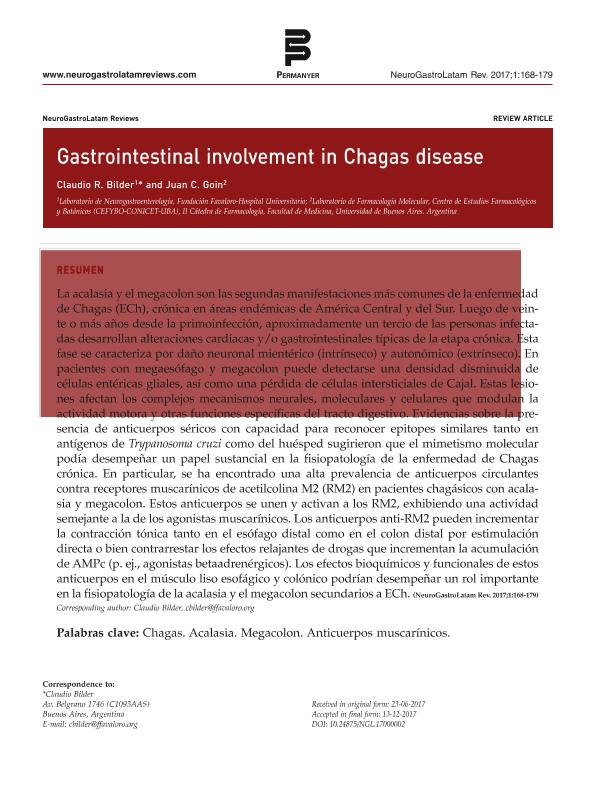Mostrar el registro sencillo del ítem
dc.contributor.author
Bilder, Claudio Rubén

dc.contributor.author
Goin, Juan Carlos

dc.date.available
2018-06-21T17:52:17Z
dc.date.issued
2017-12
dc.identifier.citation
Bilder, Claudio Rubén; Goin, Juan Carlos; Gastrointestinal Involvement in Chagas Disease; Permanyer; NeuroGastroLATAM Reviews; 1; 12-2017; 168-179
dc.identifier.issn
2462-7011
dc.identifier.uri
http://hdl.handle.net/11336/49578
dc.description.abstract
Achalasia and megacolon are the second most common manifestations of chronic Chagas disease (ChD) in endemic areas of Central and South America. Twenty or even more years after the initial infection, approximately one-third of infected people develop cardiac and/ or gastrointestinal abnormalities as typical chronic damages of ChD. The chronic phase of ChD is characterized by the damage of myenteric (intrinsic) and autonomic (extrinsic) neurons. A decreased density of enteric glial cells can be detected in patients with megaesophagus and megacolon and a loss of interstitial cells of Cajal in the latter patients. These lesions affect the complex mechanisms of neural, molecular, and cellular interactions that modulate the motor activity and other specific functions of the alimentary tract. Evidence for serum antibodies with the ability to recognize similar epitopes in both Trypanosoma cruzi and host antigens suggested that molecular mimicry could play a substantial role in the pathophysiology of chronic ChD. In fact, a high prevalence of circulating antibodies against M2 acetylcholine muscarinic receptor (M2R) in ChD patients with achalasia and megacolon has been found. These antibodies bind to and activate M2R, exhibiting agonist-like activity. Anti-M2R antibodies can both enhance tonic contraction in lower esophagus and distal colon by direct stimulation and also by counteracting the relaxant effect of drugs that increase cAMP accumulation (i.e. beta-adrenergic agonists). The biochemical and functional effects of these antibodies on esophageal and colon smooth muscle could play an important role in the pathophysiology of achalasia and megacolon secondary to ChD.
dc.format
application/pdf
dc.language.iso
eng
dc.publisher
Permanyer
dc.rights
info:eu-repo/semantics/openAccess
dc.rights.uri
https://creativecommons.org/licenses/by-nc-sa/2.5/ar/
dc.subject
Chagas
dc.subject
Achalasia
dc.subject
Megacolon
dc.subject
Muscarinic Antibodies
dc.subject.classification
Medicina Critica y de Emergencia

dc.subject.classification
Medicina Clínica

dc.subject.classification
CIENCIAS MÉDICAS Y DE LA SALUD

dc.subject.classification
Inmunología

dc.subject.classification
Medicina Básica

dc.subject.classification
CIENCIAS MÉDICAS Y DE LA SALUD

dc.title
Gastrointestinal Involvement in Chagas Disease
dc.type
info:eu-repo/semantics/article
dc.type
info:ar-repo/semantics/artículo
dc.type
info:eu-repo/semantics/publishedVersion
dc.date.updated
2018-06-01T19:26:40Z
dc.journal.volume
1
dc.journal.pagination
168-179
dc.journal.pais
España

dc.journal.ciudad
Barcelona
dc.description.fil
Fil: Bilder, Claudio Rubén. Universidad Favaloro. Facultad de Medicina; Argentina
dc.description.fil
Fil: Goin, Juan Carlos. Consejo Nacional de Investigaciones Científicas y Técnicas. Oficina de Coordinación Administrativa Houssay. Centro de Estudios Farmacológicos y Botánicos. Universidad de Buenos Aires. Facultad de Medicina. Centro de Estudios Farmacológicos y Botánicos; Argentina
dc.journal.title
NeuroGastroLATAM Reviews
dc.relation.alternativeid
info:eu-repo/semantics/altIdentifier/url/http://www.neurogastrolatamreviews.com/files/nglr_2017_1_4_168-179.pdf
dc.relation.alternativeid
info:eu-repo/semantics/altIdentifier/doi/http://dx.doi.org/10.24875/NGL.17000002
Archivos asociados
